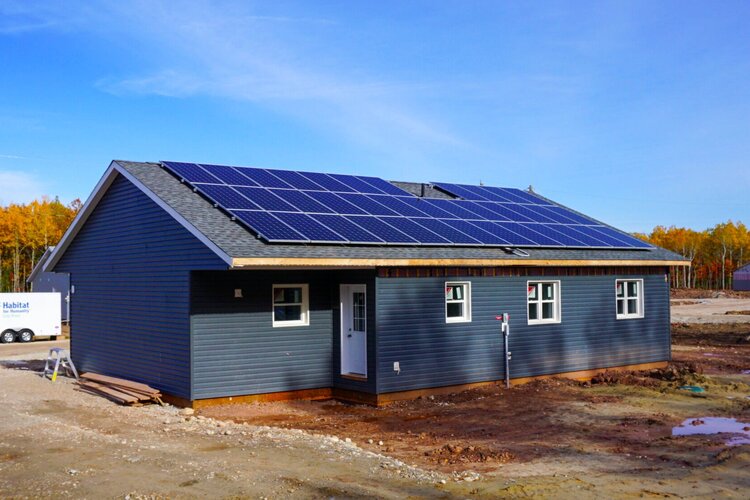As part of The Iron Warrior’s club interview series, I had the pleasure of interviewing Jessica Dulku and Gabrielle Tuck from Warrior Home. Warrior Home is a University of Waterloo design team that designs homes for competitions. A unique part of Warrior Home is how it integrates well with benefiting the community.
Do you want to give me a quick introduction to yourselves?
Gabrielle: My name is Gabrielle Tuck and I’m in 4B civil engineering and I’ve been on the team since it started in 2017. For the past two years now, I’ve been one of the senior design leads for the team.
Jessica: My name is Jessica Dulku. I am also one of the senior design leads for the Warrior Home team. I actually joined the team back in 2018 so I’ve been on the team since. I am in for 4B environment engineering. So we both have just two months left and that’s it. We’re outta here!
What do you do at Warrior Home?
Gabrielle: Essentially what we do is we compete in competitions put out by the US Department of Energy called the “Solar Decathlon”. Our first one was actually called “The Race is your Competition”, but it has sort of changed names and restructured a bit. So now, it’s the Solar Decathlon. Those competitions are essentially about designing net-zero infrastructure. In our case, it’s usually housing. We’re usually doing some sort of either multi-unit home or we’re doing single-family homes, but the competition includes schools and large buildings, retail, pretty much any kind of building that we would use typically.
So essentially, we will be doing those designs, but we also for every competition, like to partner with a member of the community. So right now, we’re doing two challenges. The first of which being the Build challenge, which is where we actually have to design and build a home. So, we partnered with the Chippewas of Nawash Indigenous community up north. It’s a reserve that’s up near Tobermory. We partnered with them and with Habitat for Humanity – partially as a financial method to help get our homes actually built, but also just that we can make a meaningful contribution outside of just as if we’re participating in a competition kind of thing. So, the house that we actually designed and built for our last competition of family moved in there about a year ago on the reserve. That was pretty cool. I’ll leave Jessica to talk about our current/future competition.
Jessica: So, I guess I’m moving on are adding on to what Gabrielle said about the competitions. Again, we have a social aspect to our team. So, in the past, it was that competition with Habitat for Humanity, and this time around, we’re working with Ottawa Community Housing, where we’re working in a closed community where they are trying to provide housing for low-income families. So that’s what our current design is focusing on right now. We do have possibilities of it being built, but we’re kind of just doing a case study for the development and the companies there. Then, from there, they’ll be able to use some of our design and hopefully implement it.
What is your favorite part about Warrior Home?
Gabrielle: I guess I kind of touched on it before when talking about our partnerships, but it’s that we’re able to make an impact. It’s kind of dual focus in that way. We get to make an impact on both the community, and the people that we’ve partnered with. But we also get to make an impact on the students that are part of our teams because oftentimes they get to learn technical skills and industry knowledge that they wouldn’t otherwise pick up until maybe their later coops or until courses in their third or fourth year. So, I like just the impact that our team can make.
Jessica: Then adding on to that because we do focus on a lot of net-zero aspects as well. So it’s also kind of going around the environmentally friendly impacts as well – that’s a huge focus on a lot of our bills, to use sustainable materials, local companies. I guess it’s a lot of the social and environmental impacts is what I really liked about the team which is why I’ve stuck around so long.
How would you describe the sense of community in your design team?
Gabrielle: The community could be described as tight-knit and welcoming. We have people on our design team from all different disciplines. There are mechanical engineers, civil engineers, environmental engineers, planning students, business students – I think we had some math students and political science students at some point—, architecture. We’re kind of just a very multi-disciplinary team. I think we’ve all grown fairly close, even though we’re all online right now.
Jessica: Very true. Yeah, 100%. I think diversity is a huge thing altogether. It’s so easy to learn because everybody brings such different things to the team. So even if you might not be in planning, let’s say, there’s so much I’ve learned about interior designing that I would have never known. Again, as Gabrielle mentioned too, it’s very welcoming. Everyone is very open to teach and learn, so that’s always been a huge plus.
What have you learned since you joined Warrior Home?
Gabrielle: I mean, aside from just technical aspects. In terms of, let’s say, for example, building enclosure design, you know you wouldn’t really learn that in your younger academic terms. So there is that aspect to it.
But I think also just learning about how projects run in terms of there being so many different stakeholders because we’ll have ourselves, who are, I guess in this sort of scenario the designers and then we also have the competition organizers, who are who we’re reporting to. But then at the same time, we’re also coordinating with, for example, for the last project, Habitat for Humanity, who’s actually building the house for us. And then we’re also coordinating with the Chippewas of Nawash who the house will be going to. So, there’s a lot learned there about coordinating different stakeholders.
Also, just learning about how integrated all the different systems are that go into a building. Mechanical systems rely on the enclosure and they all kind of integrate into that with the house or building functions. It’s just kind of cool to see that overlap.
Jessica: Another thing I’ve learned is about the community and human considerations when you’re making buildings. I didn’t realize there was so much to consider in terms of comfort, who’s going to be using the building or who’s going to be living in the home.
With the pandemic, how have you adapted to now being completely remote?
Gabrielle: Well, I mean, I guess we’ve been moving all of our meetings over to Microsoft Teams. So we’ve made a bunch of channels in there for all of our sub-teams within our team. So our team is broken up into sub-teams to cover sort of all the different aspects that go into the design. So we’ve been hosting meetings: For general meetings about every other week, but then we’ve also had online tutorials that we’ve been doing. Sub-teams host their own meetings on teams. We’ve made the best of the situation. I think it’s working pretty well.
Jessica: For sure, I was going to say it’s kind of nice. A positive note of having everything remote is that I feel a lot of students that aren’t on stream or they’re not in Waterloo. Let’s say when we had our actual meetings, they’re able to tune in whenever they want from wherever they are, so that’s kind of been a plus. And you know, you can send your PJs all day and still come to the meeting so it’s kind of nice, that part of the remote stuff. It’s been going pretty well so far.
Gabrielle: I think I might also add this playing off that point there as well. We’ve been recording a lot of our meetings, so it’s been super helpful. If you miss a meeting because you have, you know, maybe an exam the next day or you have just something else going on that you have to go to. You wouldn’t really be able to just go and watch back their recording, so it’s nice that we’re able to record it all and have that information documented. Even if you just have to go back and be like what was our final decision from that meeting, you know, what did we talk about? It’s kind of a nice aspect of online learning I guess.
How can new members join your team?
Gabrielle: We have a website warriorhome.ca. You can just go to https://www.warriorhome.ca/team and you can just click “Join Now”. It’ll automatically get you to join our MS Teams. And that’s I guess the technicalities of how you join the team.
Jessica: And then we have all the socials on every platform which everyone can just search up. We post all of our workshops and our updates. So that’s another way everybody could kind of keep in the loop with us.
Gabrielle: I think also to add onto it as well. Our team is open for anyone to join. Whether you have four years of experience or less than 30 seconds.. So it’s open to everybody. We do have sub-team lead positions and you do have to interview for those. But if you would like to be a general member and just contribute to whichever team you would like or just learn, yeah, that is definitely open for anybody to join.
Jessica: And they don’t have to be in engineering. Again, any interest they have. They could definitely just tune in.





Leave a Reply